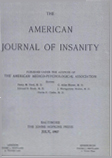NEUROCIRCULATORY REACTIONS IN THE PSYCHONEUROSES STUDIED BY THE SCHNEIDER METHOD
Abstract
The Schneider Index, which is alleged to measure cardiovascular fitness, was given to 503 psychoneurotic patients, as well as 83 schizophrenics, 71 manic-depressives, and 90 organic neurologic patients; and to 134 athletes and 191 unselected control subjects—a total of 1072 subjects. Including the subjects which were examined twice a total of 1312 indices were taken during the investigation.
The mean score for the psychoneurotics was 7.9, the manicdepressives 8.2, the schizophrenics 8.7, the organic patients 10.2, the unselected control subjects 12.6 and the athletes 14.8. If a mean score of 9 or below is taken as indicative of cardiovascular unfitness, more than 50 per cent of the psychoneurotic and psychotic patients may be so classified, with only 18 per cent of the control group and 5 per cent of the athletes. The female patients scores averaged from 1 to 2 points lower on the index than the males.
Range and variability were significantly greater for the patients than for the control subjects, in the individual items of the test as well as in the total Schneider Index.
The reliability of the index was measured by repeating the test on 70 of the psychoneurotic and 70 of the control subjects, test and retest being one week apart. The correlation was 89 for the controls and .88 for the patients. Low or negative correlations were obtained between age and Schneider Index.
The pulse rates for the patients were on the average higher than in the control groups. The mean systolic and diastolic blood pressures of the patients did not differ greatly from those of the controls, with this exception. that a large percentage of the patients showed a fall in systolic pressure on standing, while the controls generally showed a small increase with little deviation.
The different subtypes of psychoneurosis showed considerable variation among themselves. Cases of conversion hysteria scored higher than the others ; anxiety state and neurasthenia, lowest.
Access content
To read the fulltext, please use one of the options below to sign in or purchase access.- Personal login
- Institutional Login
- Sign in via OpenAthens
- Register for access
-
Please login/register if you wish to pair your device and check access availability.
Not a subscriber?
PsychiatryOnline subscription options offer access to the DSM-5 library, books, journals, CME, and patient resources. This all-in-one virtual library provides psychiatrists and mental health professionals with key resources for diagnosis, treatment, research, and professional development.
Need more help? PsychiatryOnline Customer Service may be reached by emailing [email protected] or by calling 800-368-5777 (in the U.S.) or 703-907-7322 (outside the U.S.).



